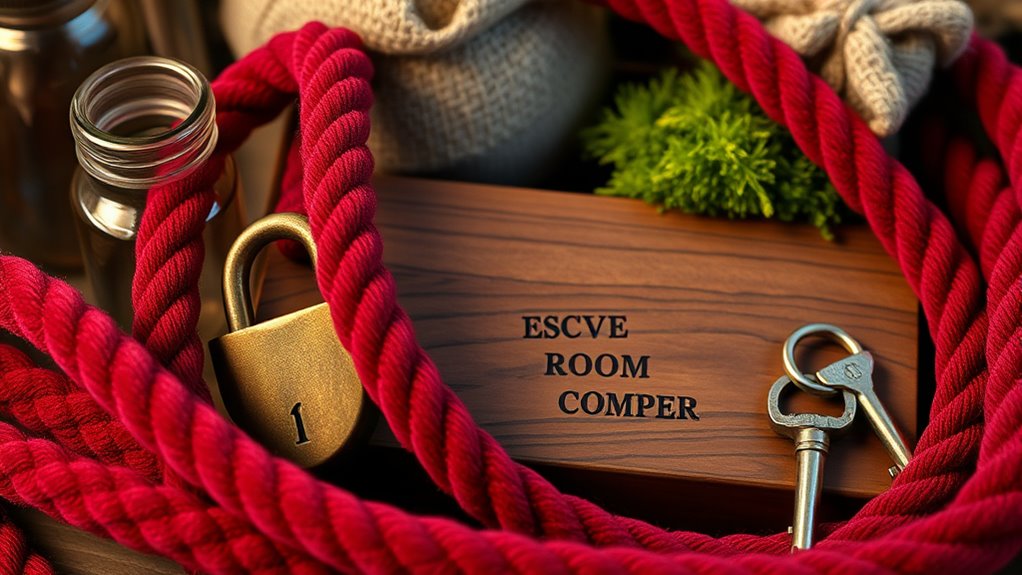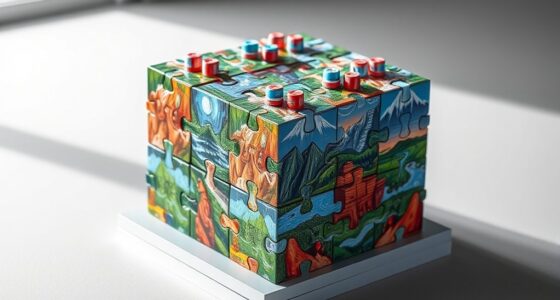In escape room puzzle kits, incorporating sensory elements like tactile feedback and auditory cues makes your experience more immersive and exciting. You’ll notice authentic textures, clicking mechanisms, and sound effects that guide your actions naturally and amplify realism. These features encourage keen observation and intuitive responses, turning puzzles into engaging adventures. To discover how these sensory details transform your challenge into a memorable story, explore further below.
Key Takeaways
- Incorporating tactile feedback such as clicks, resistance, and textured surfaces enhances realism and guides players intuitively.
- Auditory cues like sounds and chimes confirm actions, providing immediate feedback and increasing immersion.
- Multisensory environments combine touch and sound to create authentic, engaging puzzle experiences.
- Sensory elements elevate puzzle kits from simple mechanisms to immersive, story-driven adventures.
- Engaging multiple senses encourages keen observation, creative thinking, and a more satisfying solving experience.

Escape room puzzle kits have become increasingly popular because they offer immersive experiences that challenge your problem-solving skills. When you immerse yourself in these kits, you’re not just solving puzzles on paper; you’re engaging multiple senses to create a fully immersive adventure. Two essential sensory elements that elevate this experience are tactile feedback and auditory cues. These elements help you feel more connected to the environment, making each discovery more satisfying and realistic.
Immersive escape room kits engage multiple senses, with tactile feedback and auditory cues making discoveries more satisfying and realistic.
Tactile feedback plays a key role in how you interact with puzzle components. When you pick up a key, slide a panel, or turn a dial, the physical sensation of clicking, resistance, or smooth movement adds a layer of authenticity. This tactile input guides your actions naturally—you instinctively know if you’ve successfully open a compartment or if a piece fits snugly into its slot. High-quality tactile feedback can also include textured surfaces that hint at their purpose or significance, encouraging you to explore further without overt instructions. For example, a rough surface might indicate a clue hidden behind a textured panel, prompting you to investigate further. This sensory element keeps you engaged, making the puzzle-solving process more intuitive and satisfying.
Auditory cues further enhance the immersive experience by providing real-time feedback that confirms your actions or hints at hidden clues. The sound of a latch clicking open, a soft chime when solving a puzzle, or even ambient noises that mimic a mysterious environment can all deepen your involvement. These cues help you understand whether you’ve made progress or need to reconsider your approach. For instance, a subtle beep when entering the correct code reassures you that you’re on the right track, while a dissonant sound might signal an incorrect attempt. Incorporating auditory cues also heightens your focus, encouraging you to pay close attention to your surroundings. This sensory input can make the difference between a straightforward puzzle and an engaging challenge that requires keen observation and intuitive responses.
Together, tactile feedback and auditory cues create a multisensory environment that immerses you fully in the escape room experience. They stimulate your senses, making each discovery feel more genuine and rewarding. When these elements are thoughtfully integrated into puzzle kits, they turn simple mechanical tasks into a captivating adventure. You become more than just a solver; you feel like you’re part of a story, actively interacting with clues and mechanisms that respond to your touch and sound. Incorporating sensory elements enhances engagement and immersion, transforming the puzzle-solving journey into a memorable and dynamic experience. This sensory-rich approach transforms the puzzle-solving process into a captivating, memorable journey, encouraging you to think creatively while engaging your senses at every step.
Frequently Asked Questions
How Do Sensory Elements Enhance Player Engagement?
Sensory elements boost your engagement by making the experience more immersive. Tactile feedback lets you physically connect with puzzles, heightening your focus and excitement. Auditory cues guide you subtly, building suspense and helping you solve clues faster. When you interact with these sensory elements, you become more involved in the story, making the escape room feel real and exciting. This active engagement keeps you motivated and deeply immersed throughout the challenge.
Are Sensory Components Safe for All Ages?
Like Pandora’s box, sensory components can surprise you, but you must guarantee they’re safe for all ages. You should consider age-appropriate considerations and allergy safety guidelines before including tactile, auditory, or visual elements. While generally safe, some textures or scents can pose risks for young children or allergy sufferers. Always test components thoroughly, provide warnings, and choose hypoallergenic materials to keep everyone safe and engaged.
What Materials Are Used for Sensory Elements?
You use a variety of materials for sensory elements, including tactile textures like soft fabrics, rough sands, or squishy gels, and visual cues such as bright colors or reflective surfaces. These materials are chosen for safety and engagement, ensuring they provide sensory stimulation without risk. When designing your escape room puzzle kits, select non-toxic, durable items that stimulate the senses safely, making the experience enjoyable and accessible for all players.
How Do Sensory Elements Influence Puzzle Difficulty?
Sensory elements like tactile feedback and auditory cues can increase puzzle difficulty by about 30%, according to recent studies. When you incorporate these elements, you challenge players to rely on more than just visual clues, engaging their senses actively. Tactile feedback makes solving puzzles more immersive, while auditory cues can add layers of complexity, requiring you to interpret sounds carefully. This sensory engagement can either enhance or hinder progress, depending on how well it’s integrated.
Can Sensory Features Be Customized for Themes?
Yes, you can definitely customize sensory features for themes. With themed sensory customization, you tailor tactile, auditory, and visual elements to match your escape room’s theme, creating a more immersive experience. Personalized tactile features, like textured surfaces or scent-infused objects, enhance engagement and make puzzles more memorable. This customization allows you to craft unique challenges that align perfectly with your story, heightening excitement and immersion for players.
Conclusion
Incorporate sensory elements to engage, challenge, and immerse players. Use tactile textures to provoke curiosity, visual cues to spark recognition, and sounds to heighten tension. Balance these elements to create an experience that excites, puzzles, and captivates. When you master sensory integration, you transform a simple puzzle into an unforgettable adventure, where players see, feel, and hear every detail. Embrace sensory elements to elevate your escape room from ordinary to extraordinary.








